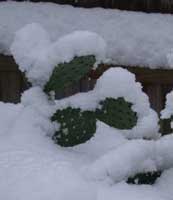 Hardy Cacti and Succulents
Hardy Cacti and Succulents
Winter hardy cacti are a natural choice for exotic gardens. Why not give them a try in that hot, dry garden spot where no other plant succeeds? They do lend a particularly exotic feel to the garden.
Perfectly suited to hot, dry summers and moderate winters, these cacti can be hardy to minus 40 degrees Fahrenheit and grow in brutally hot exposures that few plants can withstand. Their unique beauty, colourful blooms and low maintenance requirements make them deserving of a first and even second look.
Cacti thrive with maximum sunlight and full exposure to drying winds. Choose a south, west or southwest exposure. To survive European winters, all cacti need loose soil and excellent drainage.
Unlike other garden plants, the challenge in growing cacti is the elimination of excess moisture.
Both sun exposure and drainage requirements can be met by using ample gravel or sand on a sunny hill or raised bed. Five inches of sand with a small amount of organic matter mixed in is ideal. A thin mulch of stone chips or gravel will reduce the chances of crown rot.
Cacti naturally reduce their moisture content and shrivel with the onset of winter. Dehydration prevents cactus cells from bursting when they freeze. Excess moisture during autumn months can cause cacti to hold too much water and suffer freeze damage.
Most cacti also change colour in winter. This natural occurrence has nothing to do with the plants being sick. As plants become less active and the amount of green chlorophyll decreases, the red, orange and other colour pigments show through the pads or stems.
Don’t mulch cacti for winter protection. Mulches retain too much moisture. The only safe ground-level cover is snow. An above ground cover that protects cacti from excess moisture may be helpful for the more difficult ball-type varieties.
Types of cacti that are winter hardy include Opuntia (prickly pear), Coryphantha, Echinocereus, Pediocactus and Neobesseya. Of particular interest are some of the following recommended Opuntia species: Opuntia compressa - fast growing with numerous yellow flowers and few spines; Opuntia humifusa - large yellow flowers and edible fruit; Opuntia polyacantha - yellow flowers and numerous spines; Opuntia fragilis - a smaller sized plant with large yellow flowers; Opuntia rhodantha - spiny with pink flowers.
Hardy ball-type cacti that may need protection from excess moisture and humidity include: Coryphantha vivipara - pink or yellow flowers; Echinocereus viridiflorus - yellow flowers;Echinocereus triglochidiatus - red flowers; Neobesseya missouriensis - yellow flowers; Pediocactus simpsoni - pink flowers.
The best way to grow ‘hardy’ cacti is in a raised rockery. The rockery should ideally face south (if you are in the northern hemisphere). The rockery is best with a base of rubble/rocks. These rocks do not need to be ‘pretty’ because no-one is going to see them when it’s finished. Above this rubble should be a layer of gravel followed by a layer of pure grit and then the growing medium.
All these layers provide good drainage, but it is beneficial to have other hardy, non-cactus plants such as Yucca filamentosa, and other hardy Yuccas. Hardy succulents such as Agaves (A. utahensis, A. salmiana) sedums, sempervivums and chiastophyllums, and non-succulents like Rudbeckias and grasses may also be used.
You can take a look at the author's hardy cactus garden in Surrey, UK, here
